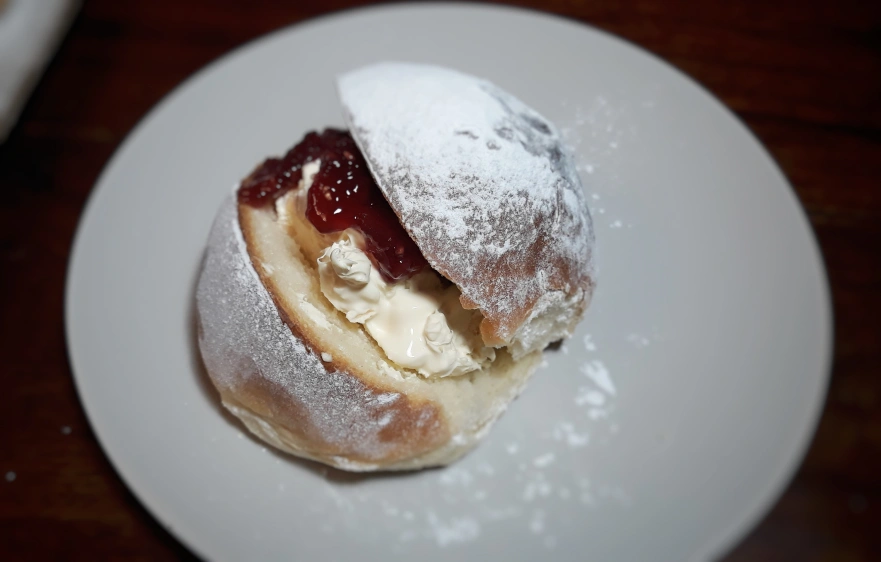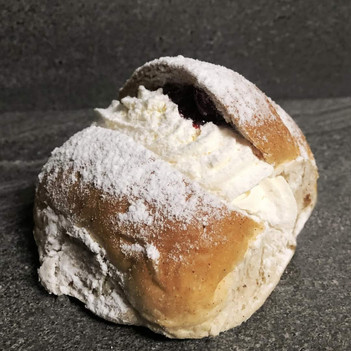Are we British ashamed of cream buns?
- rosemary
- Jul 18
- 7 min read
"The fisherman fishes as the urchin eats cream buns, from lust".
T. H. White

I actually started out with the idea of doing an oddments post, and so flicked through my list of potential oddments, where I found 'cream buns'. I have no idea why it was there - maybe I was just feeling nostalgic one day. So I started exploring the web for pictures and a few words, and pretty soon was into more than I expected, so it has become a post of its own. This is what I was thinking of when I started out though - Cream buns as described on the Christina's Cucina website. It looked just like the cream buns that I remembered from my childhood, and university café splurges.
Only the cream in those buns back then, was not, I'm sure, real cream, but possibly something from a metal spray can. The buns were reliably feather light, and so also probably full of chemicals. But I did love them. Did my mother make them every now and then? I'm really not quite sure.
Anyway it was actually Christina of Christina's Cucina who sent me on today's ramble around the web, and in true literary fashion I actually almost ended up with Christina as well, until I remembered to check out Ottolenghi.
The first surprise was to discover that cream buns are Scottish. A surprise because, in the way of any inhabitant of each component of the British Isles, we tend to think our favourite things come from the bit that we come from. So of course, I thought they were English, and that Scotland didn't have any sweet treats to reckon with - just haggis, neeps and tatties and whisky - well fish as well. So I double-checked my post on the food of Scotland From world's worst to best - Scotland to see if I had forgotten to include them, but could only find Well-fired rolls - shown below, which are as unattractive to me as haggis. And they are not sweet - although I was reminded of the excellent shortbread and cranachan, but also the dreadful fried Mars bars.
Christina maintained that cream buns were not popular in England - which is just not true - they were a staple of every baker's back then. and I'm sure you can buy them by the truckload in any English supermarket. She did mention Cornish splits - however, a recipe for which and information can be found, on Neil Buttery's excellent British Food: a History website. He maintains that such buns were found all around the country, but it was in Devon and Cornwall that cream and jam were added - which, of course, makes sense. He also explains that the buns are so soft because they are made with butter and with milk as well as yeast. Paul Hollywood has a version of Devonshire splits - that he decorates with strawberries rather than jam.
In the same paragraph Christina mentioned Maritozzi - an Italian cream bun, and from there I rambled some more around the corners of the internet dedicated to such mild curiosities.

Interestingly the very first site and recipe I found for maritozzi was from Elisa Pietrantonio of Taste, Australia, together with a lengthy explanation of it all, particularly the modern custom of an Italian breakfast consisting of a sweet treat such as a maritozzo, and shot of espresso coffee. When in Rome she tried as many as she could of:
"Italy’s answer to the humble cream bun and Rome’s most iconic pastry, maritozzi are soft, sweet, brioche-style buns scented with honey and citrus and filled with a generously thick wedge of light and fluffy sweetened whipped cream."
So not the same kind of dough as a British cream bun, and also flavoured with more than just sugar:
"These maritozzi are made of an enriched brioche-style dough that includes extra virgin olive oil, sugar and egg yolk. I start my dough by making a lievitino (a type of pre-ferment, similar to a poolish). Because oil, sugar and egg yolk can all slow down the leavening of a dough, a lievitino gives the yeast some time to multiply and grow unhindered, helping to boost the rise of the dough as well as the flavour, to create a brioche that is softer and more fragrant."
And the cream doesn't have to be plain either:
"consider the whipped cream a blank canvas for sliced fruit, chopped nuts and chocolate. You can also flavour the cream with your favourite spread or even spoon some of your favourite jam into the cut buns before filling with the cream."

At this point I turned to Rachel Roddy of course, who accompanied her recipe for Maritozzi with the history - where I discovered that these are traditionally (no more), a pre Lenten treat. A Shrove Tuesday thing, like our pancakes:
"At some point in the Middle Ages, Roman breads and small loaves, sweetened with honey and dried fruit, evolved into quaresimali (almond biscuits for Lent). Restrained enough to be considered a Lenten abstinence (no animal fat and not too sweet), quaresimali were – according to the Roman writer Livio Jannattoni – good enough “to satisfy greed without putting you in a position of sin”. Maritozzi ... is an 18th-century name for a variant of quaresimali, split and filled with cream, which according to legend was given to girls by suitors to ensure they became their marito (husband)." Rachel Roddy
Which sort of explains the name because maritozzo is "an affectionate derivative of marito, which means husband." - Eleonora Glasso.
An aside - when I had finished all my internet searching I decided to test out my two most comprehensive Italian cookbooks - yesterday's The Food of Italy, and Italy the Beautiful, only to find that neither of them had a recipe and neither did those 'old' Italian gurus Elizabeth David and Claudia Roden - and yet Nigella did, but not Jamie. Maybe the Italians too regard them as too everyday to be included in the highlights of their cuisine, whilst we outsiders find them exotic.
As always, one thing leads to another and one of these people - I now can't remember who, told me that Scandinavia and particularly Sweden with its Semlor - as demonstrated on the website What's for Lunch Honey? have a whole range of varieties of cream bun - laskiaispulla (Finland), fastelavensbolle (Norway), fastelavnsbolle (Denmark), vastlakukkel (Estonia) where, like the maritozzi they are a Lenten thing. The traditional version has a marzipan like filling, on which the lid of the bun and then cream are balanced. The recipe I chose to represent this particular kind of cream bun went for jam rather than marzipan - from the What's for Lunch Honey? website.
Originally, they were a pre-Lent treat, but now you will find them on sale from 2 January until end of Easter. And the Scandinavians have made them into a big thing - no longer :
"a 16th-century plain bread bun served in a soup of warm milk eaten only on Shrove Tuesday in preparation for the 40-day fast of Lent. ... Social media has turbocharged the popularity of the traditional buns but also transformed them almost beyond recognition." Miranda Bryant/The Guardian
Turbo charged so much that there are endless varieties on sale in the shops, and in Denmark Noma - one year on the day they call Fat Tuesday, had a special edition one, which generated long, long queues even before 7am opening time:
Plain British cream buns - yes let's call them British to include all of we inhabitants of the sceptred isles, might be loved, but certainly don't generate such mania. Not that that mania is new, In 1771 King Adolf Fredrik of Sweden died:
"after consuming 14 of these creamy buns of goodness which were soaked in warm milk (a traditional way to eat them)." Christina's Cucina
And one explanation of their popularity in Sweden comes from the Noma pastry chef Francisco Migoya, responsible for those queues: "it starts to signal that spring is coming and better and sunnier and warmer days are coming.”
Even Nigel Slater, who has two recipes for cream buns - one slightly more traditional than the other associates them with the end of winter:
"Rising early also gives me the chance to bake. A simple loaf or a batch of buns, the most foolproof of doughs enriched with egg and milk and a little sugar, to be baked, torn open and stuffed with jam and whipped cream. Treats such as this are a reward for a morning’s gardening, an afternoon pick-me-up between raking fallen leaves from the paths and repotting some of the winter herbs. The buns are good split and toasted, too, perhaps with ricotta and marmalade or crushed raspberries and clotted cream." Nigel Slater
His two recipes? Both very homely looking: Sweet vanilla cream buns and Sweet buns with cream and jam
The first lot are almost as messy looking as something that I might have made.
In spite of the majority of the Brits ignoring recipes for cream buns - Jamie, Delia, Mary Berry et al. some of the more adventurous cooks on the British scene experimented a bit - Benjamina Ebuehi with her Coconut and lemongrass version and Ottolenghi with his Maple cardamom saffron sticky buns. Neither of them quite the same, but almost.
I was about to give up when, surprise, surprise I found that Australia - specifically South Australia has also got in on the act with the Kitchener bun, previously known as the Berliner, but renamed in WW2 for political reasons according to Bush Cooking. The version shown below won the competition for the best SA Kitchener Bun. However, this variation is maybe a step too far as it is fried before filling with cream - a sort of cross between a cream bun and a doughnut. A move from one genre to another. Although I also saw a Facebook posting of an Australian school cream bun. Did they hand out cream buns in school? Or were they a traditional offering in school canteens?
But yes, not a lot of recipes from the British for their guilty pleasure cream buns. Maybe that's because we know they are not good for us, and besides, these days we seem to prefer the fancy rathet than the plain.
YEARS GONE BY
July 18
2024 - Spaghetti pie, cake, slice
2020 - Deleted
2019 - Forgotten celebrations
2017 - Nothing
2016 - Breakfast
































Only 3 stars because the topic of cream buns is so alienating for me that I am feeling slightly poorly just reading about them. Chocolate Croissants YES. Cream Buns NO. Sorry! 😱